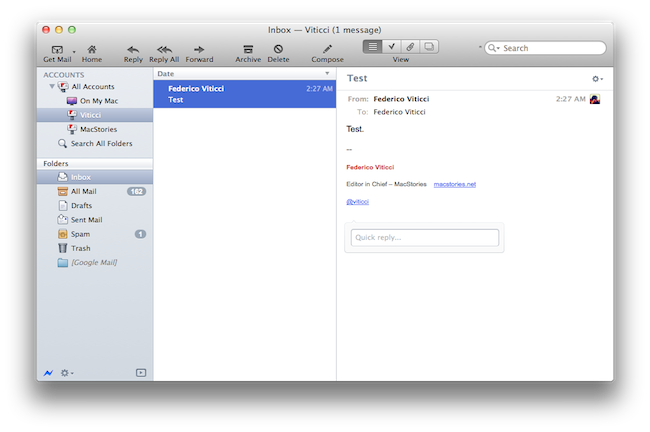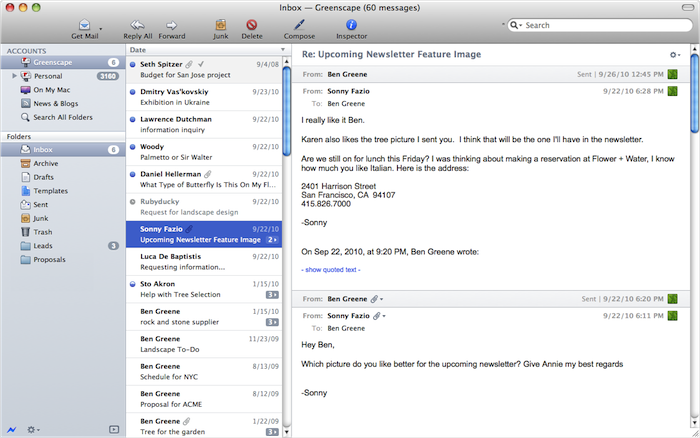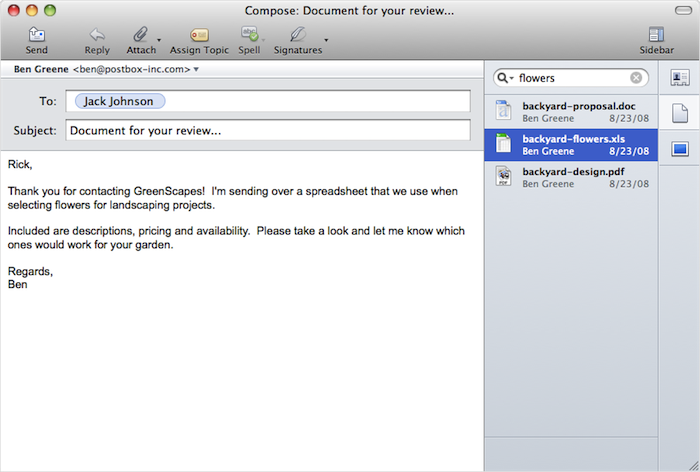Earlier today, we published an article detailing some of the interface changes set to be introduced in Postbox 2.5, a major update for the popular alternative email application for Mac and Windows that, among other things, was teased by the developers as one of the biggest rewrites of the app to date. With a series of blog posts, the Postbox team had in fact already announced that the client would get an overall improved interface, new toolbar icons on the Mac, a completely re-imagined message view, and a vertical pane view to take advantage of widescreen monitors – admittedly one of the glaring omissions from the previous versions of Postbox.
Postbox 2.5 is now available and it’s a free upgrade for existing 2.x customers. As previewed in our original blog post, the app comes with a refreshed interface on OS X, as well as full 64-bit support that should make for faster loading times, snappier message viewing and a general performance improvement. The new UI has two sets of toolbar icons, a colored one to match the current style of Snow Leopard’s Aqua interface, and a set of monochromatic icons that follow the steps of recent iTunes updates and Lion Developer Previews. I’ve been able to run the new Postbox only for a couple of hours, and I’m not sure which style I like better yet. However, I can say that whilst I’ve using the colored icons this evening, I can see how in the long term monochrome could be a better fit for users jumping onto a Lion upgrade.
As far as other redesigned parts of the interface go, changes are welcome. The message view is now more streamlined to accomodate a better layout and less clutter all around; on the other hand, the obvious choice of implementing a widescreen layout ensures a finally-optimal experience on 15-inch and 17-inch MacBooks (let alone iMacs and Cinema Displays). The old layout is still available, and can be changed from the View menu in the status bar.
Another big change is the redesigned compose screen and addressing widget in Postbox 2.5: in what could be seen as some sort of similarity with iOS 5, email addresses can now be dragged into and out of the standard To, Cc and Bcc fields to adjust the settings of a message that needs to be sent. The entire addressing widget has been rewritten so that the compose window can be adjusted to show or hide Cc, Bcc, Reply-To, etc. Once auto-completed from the OS X Address Book, contacts turn into a blue bubble that can bring up a contextual menu upon right-click – this is a welcome update as it’s the way contacts should always work on a Mac. In the same compose window, a sidebar on the left allows you drop contacts, attachments (found in the mail database) and images into your outgoing message.
In spite of the more lightweight interface and 64-bit support, I’ve found, however, Postbox to require more memory than Mail.app to operate. I don’t know if the app has already been optimized to run on Lion, but the version I tested on DP 4 often ended up eating 300 MB of RAM, whilst Mail was comfortable with 100 MB and four more accounts configured. Like I said though, I don’t know if the developers have already made changes to their code to fully support Lion’s new architecture and frameworks.
One of the complaints I usually hear about Postbox is that it’s not really native to the Mac platform, and most of the “integration” Mail.app sports is nowhere to be found in it. Now, I don’t know if some of these features had already been implemented before version 2.5, but when looking through Postbox’s extensive documentation for the Mac I was surprised to find out that the things many people say aren’t actually true: the app integrates with OmniFocus for task creation (though, yes, the Clip-O-Tron 3000 plugin won’t work); Postbox 2.5 introduces Spotlight indexing for topics set in the email application; AppleScript support allows you to send messages using Postbox from other apps like Alfred and iCal. So while Mail.app is surely the king of system integration because it’s a native app from Apple with hundreds of different plugins available online, Postbox isn’t as bad as several users describe it on the Internet. In case you ever need it, here’s a full list of menu items from Postbox 2.5.
Overall, I feel like Postbox 2.5 is the right path to follow towards a (likely) 3.0 major update that I expect to be focused on making the app even more tightly integrated with OS X Lion and, perhaps, Apple’s new iCloud services. I’m just speculating here, so we’ll see. Right now, I can say Postbox 2.5 builds on the excellent feature set of version 2.1 to bring a more streamlined interface, some stylish icons and a general polish that dramatically improves the email experience on the Mac. I’ve only scratched the surface of what Postbox can do with this 2.5 review, as the app is a serious tool for people who want to get things done with email, rather than just responding to messages.
You can download a free trial of Postbox or buy the full version from the developers’s website, otherwise if you don’t mind having a version without support for add-ons (which I don’t use, and this one’s an Apple limitation), feel free to get it on the Mac App Store at $19.99.
Update: Postbox 2.5 isn’t available yet on the Mac App Store, but you can download it directly from the official website.




